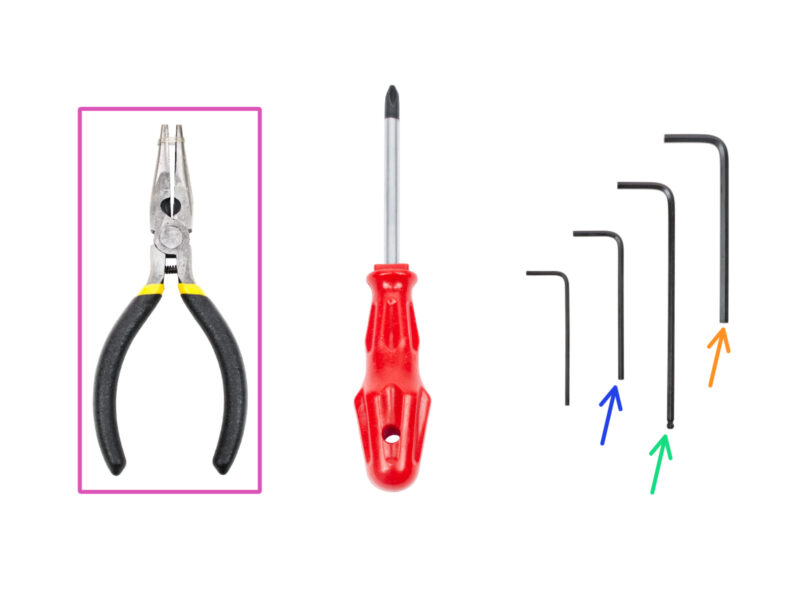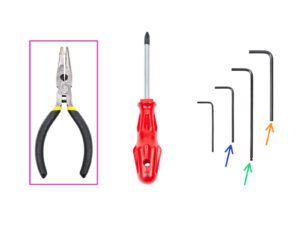English
1. Tools necessary for this chapter
Step 1 of 39 (Chapter 3 of 10)
Contents
Comments
⬢Needle-nose pliers
⬢2mm Allen key for nut alignment
⬢2.5mm Allen key for M3 screws
⬢3mm Allen key for M5 screws


Contents
Original Prusa i3 MK3S+ kit assembly (v3.26)
- 1. Introduction
- 2A. Y-axis assembly
- 2B. Y-axis assembly
- Tools necessary for this chapter
- YZ frame - preparing the components
- YZ frame - mounting the longer extrusions
- YZ frame - mounting the shorter extrusions
- YZ frame - final check
- Y-axis: front and rear plate preparation
- Y-axis: front plate assembly
- Y-axis: preparation for the PSU
- Y-axis: rear plate assembly
- Y-axis: geometry check
- Mounting antivibration feet (optional)
- Preparing Y-belt-idler (part 1)
- Preparing Y-belt-idler (part 2)
- Preparing Y-belt-idler (part 3)
- Mounting the Y-belt-idler
- Y-axis: motor and motor holder
- Preparing Y-motor-holder
- Mounting Y-motor-holder
- Y-axis: Y-carriage
- Correct bearing orientation
- Installing bearings on the Y-carriage
- Inserting smooth rods into Y-carriage
- Y-axis: smooth rods holders
- Preparing Y-rod-holder
- Mounting the Y-rod-holder parts
- Installing the Y-carriage
- Aligning the smooth rods
- Assembling the Y-motor pulley
- Y-axis: Assembling the belt
- Y-axis: Assembling the belt
- Y-axis: Assembling the belt
- Y-axis: Assembling the belt
- Y-axis: Assembling the belt
- Y-axis: Assembling the belt
- Aligning the Y-axis belt
- Tensioning the Y-axis belt
- Testing the Y-axis belt
- Haribo time!
- Y-axis is finished!
- 3. X-axis assembly
- 4. Z-axis assembly
- 5. E-axis assembly
- 6. LCD assembly
- 8. Electronics assembly
- 9. Preflight check
- Manual changelog MK3S+ kit
Comments
Log in to post a comment
jm2070
•
I used an empty fishing tackle storage box to hold all the hardware as it was used. I left the hardware in the bags until the applicable step, then separated the hardware in the tackel box. I also used a magnetic mechanics dish to hold the hardware for each step. Some hardware was stainless so not magnetic, but any old bowl would do. I'm sure there are a million ways to organize the hardware, with everyone having their own preference. Just know that everything needed is there somewhere. It may take 5 minutes to find it and verify it's the right item. Remember you ordered the kit instead of prebuilt, lol. In the long run building the printer yourself will allow you to troubleshoot any issues much easier. I personally enjoy building things, so to me this is great fun. Relax, slow down, and enjoy the project.
KJ
•
First experience was great till this step. Totally unclear what is in which box. Why not add that to the manual or color code or anything. In the end I needed to open every box.
David
•
Hi! Tools are in the bag labeled 0.TOOLS. If there is anything missing from your kit, please, contact support via shop.prusa3D.com
Dirk
•
I would suggest to put the tools in a bag labeled "1. Tools"It would prevent the confusion when looking for a bag labeled 1.
mtpiercey
•
Perhaps mentioning that that bag is in the box marked "MK3S+ Fasteners & ELE" would be sufficient. I was able to see the bag right away after opening that box, but I just guessed that that was the right box to open first.
jhon59
•
the frist thing I do befor opening any pakages of scerws was I used a saucer but use anything put the scerws in the saucer it spreads them out so can fid what im looking for I can grab them with the needle nose plieres and I don't lose them